AP Psychology (Unit 2 and 3): COMPLETE
1/373
Earn XP
Description and Tags
Examples are written in italics
Name | Mastery | Learn | Test | Matching | Spaced |
|---|
No study sessions yet.
374 Terms
What is perception?
How the brain interprets and organizes the sensory inputs
What is visual perception?
The process by which the brain interprets and organizes visual information received through the eyes
What does the brain use to perceive visual information (depth)?
Monocular and binocular cues
What are monocular depth cues?
Rely on one eye to perceive depth
What do monocular depth cues include?
Relative size, texture gradient, interposition, linear perspective, and relative clarity
What is relative size?
Objects farther away appear smaller on the retina
What is texture gradient?
Objects farther away appear smoother
What is interposition?
When a near object blocks the view of a distant one
What is linear perspective?
When parallel lines appear to converge as they recede into the distance, meeting at a vanishing point
What is relative clarity?
Objects farther away appear blurrier
What are binocular depth cues?
Rely on both eyes to perceive depth
What do binocular depth cues involve?
Retinal disparity and convergence
What is retinal disparity?
Perceiving depth using the difference in distance between the two images from both eyes
What is convergence?
When the eyes turn inward to focus on nearby objects
What does the Gestalt principle explain?
How we group stimuli to create meaningful wholes
What does the Gestalt principle include?
Proximity, similarity, symmetry, continuity, figure and ground, and closure
What is proximity?
Grouping nearby objects
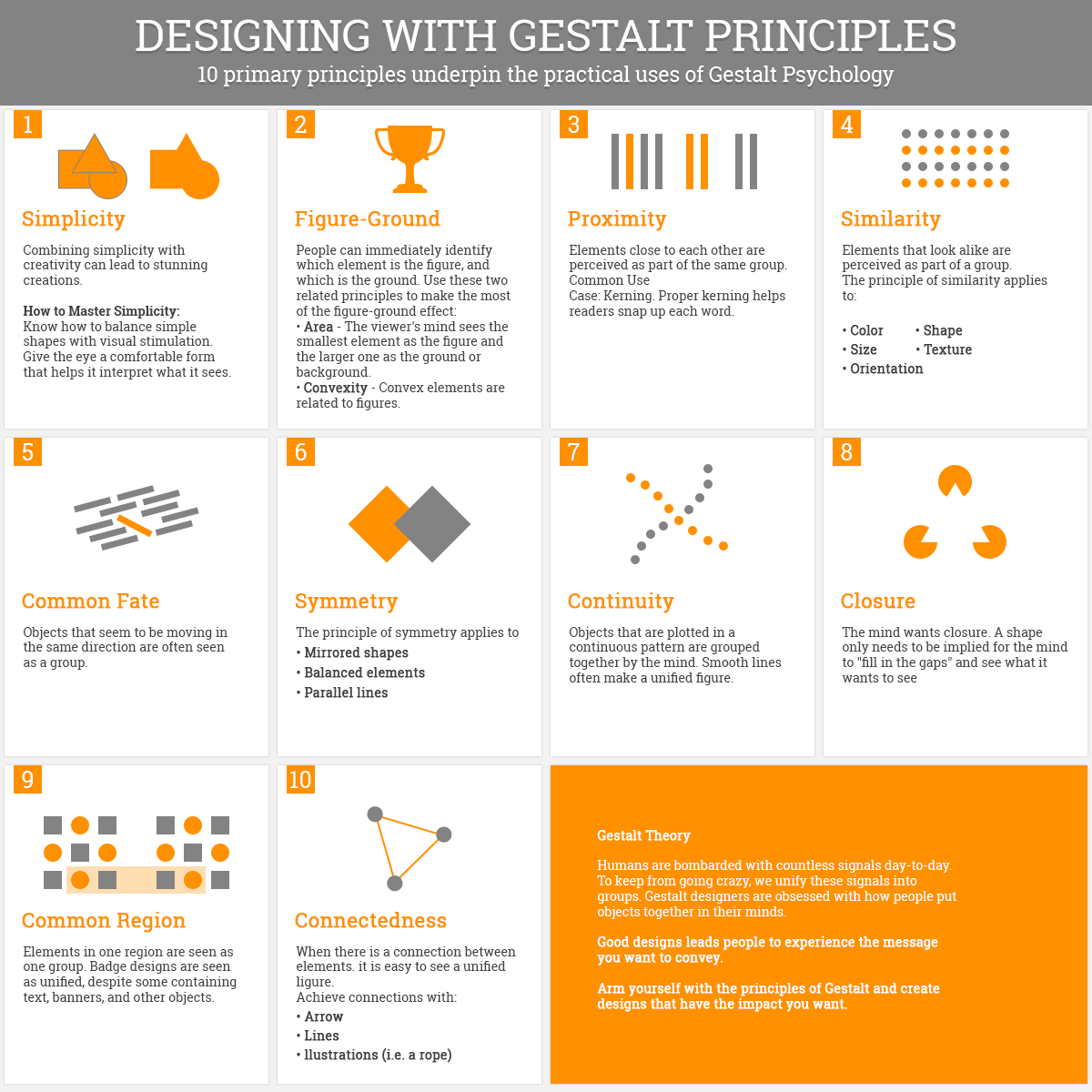
What is similarity?
Grouping similar objects
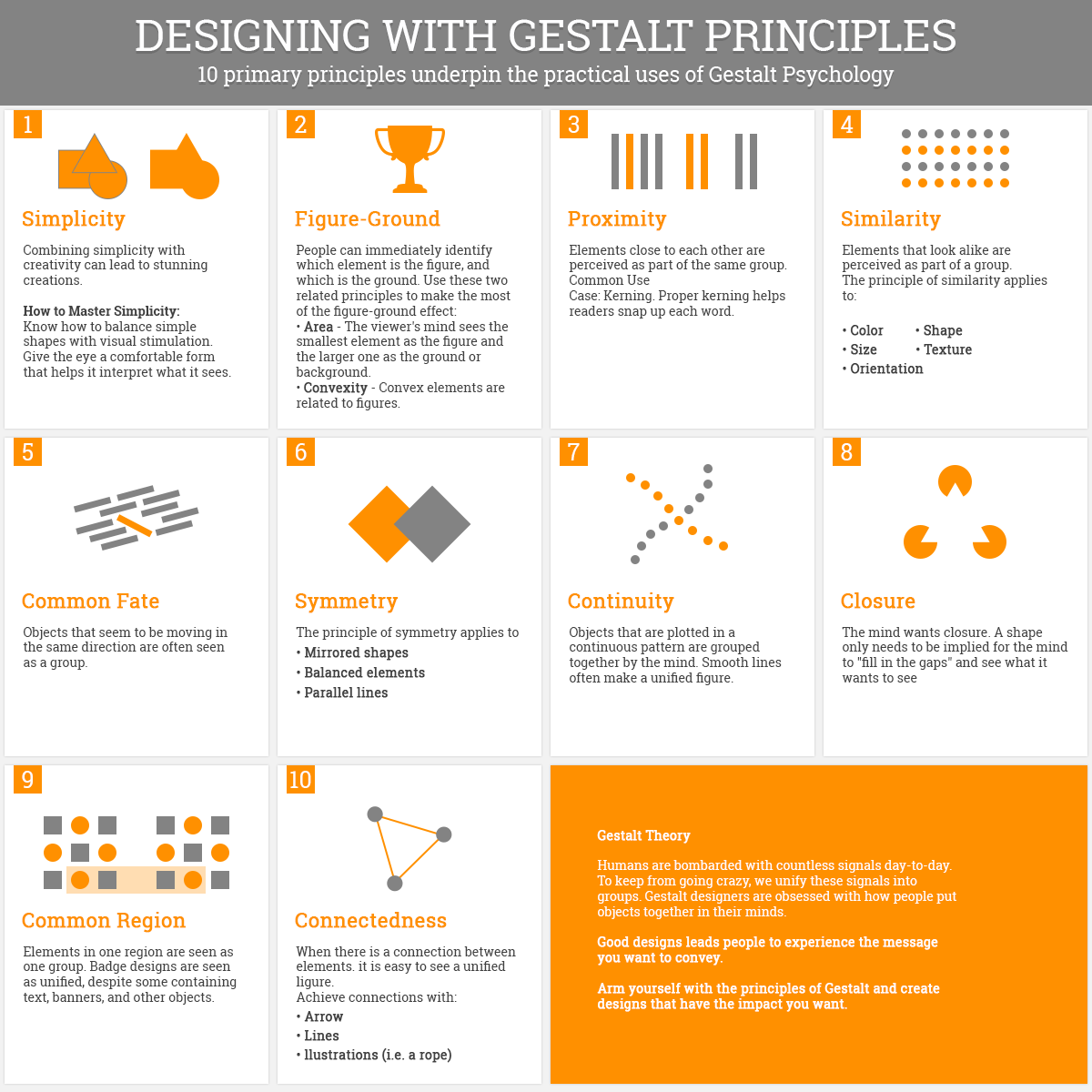
What does the similarity principle explain?
Why anomalies (objects different than others) become our focal point
What is symmetry?
Perceiving objects as symmetrical
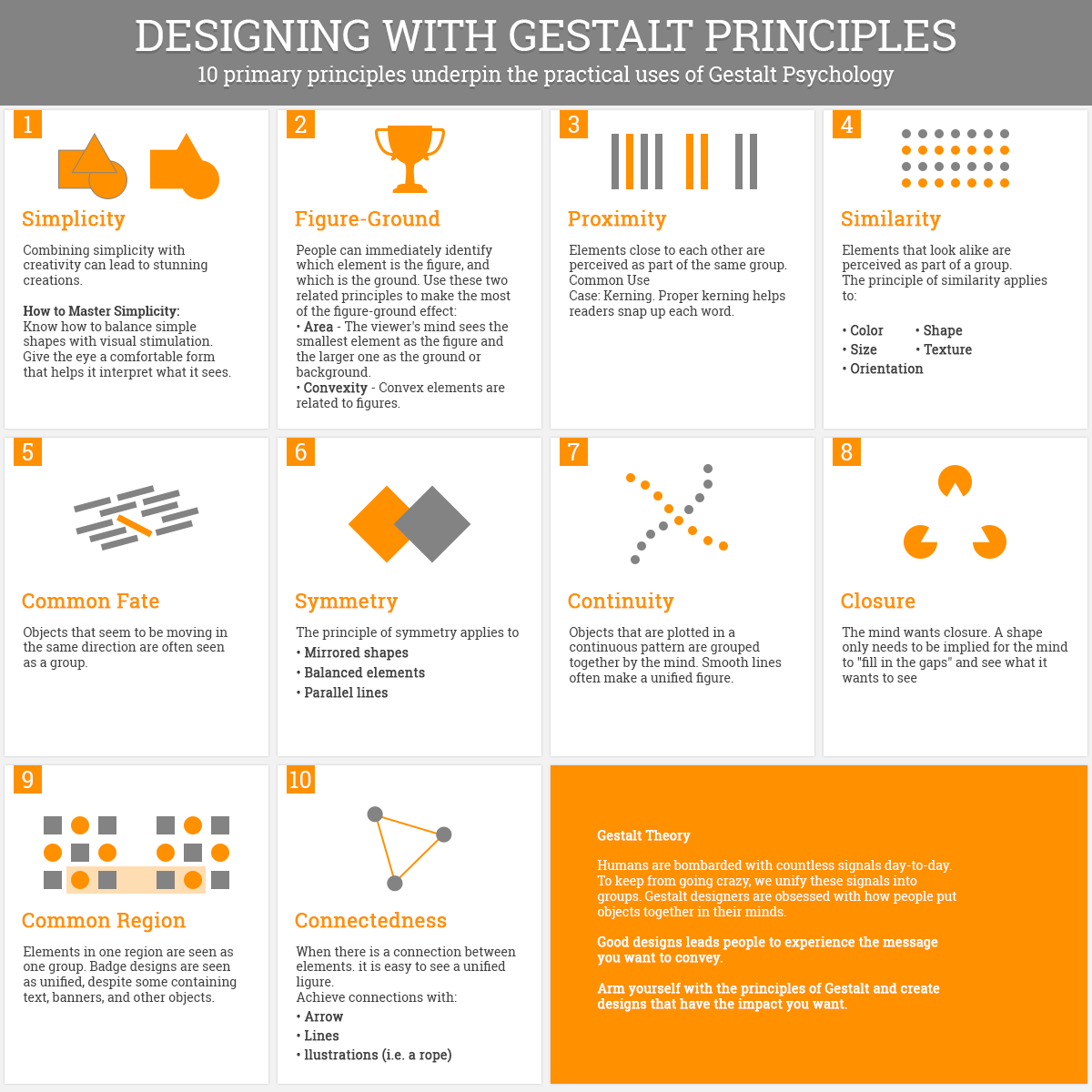
What is continuity?
Seeing smooth, continuous forms
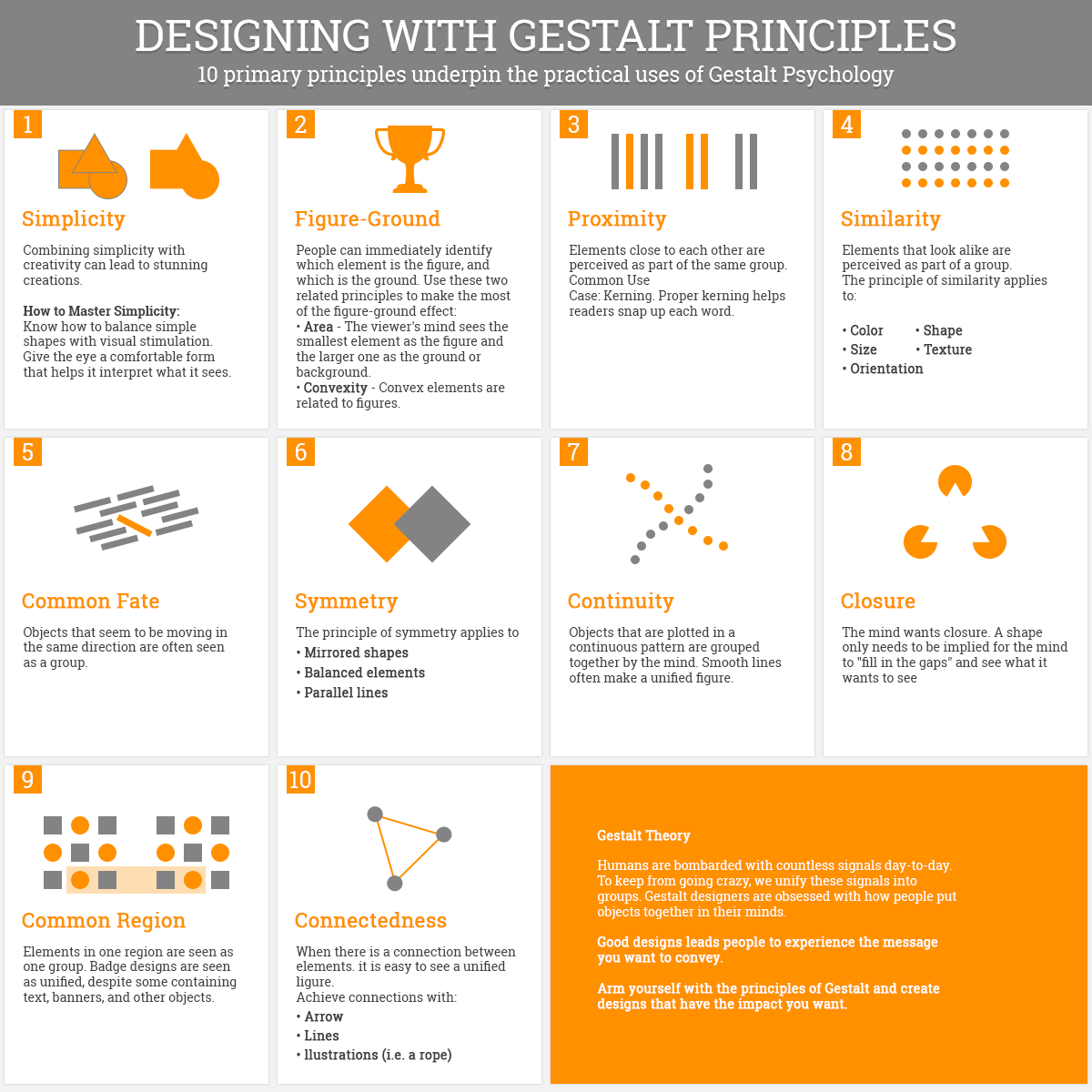
What is figure and ground?
We separate what we see into two categories: object of focus and the background
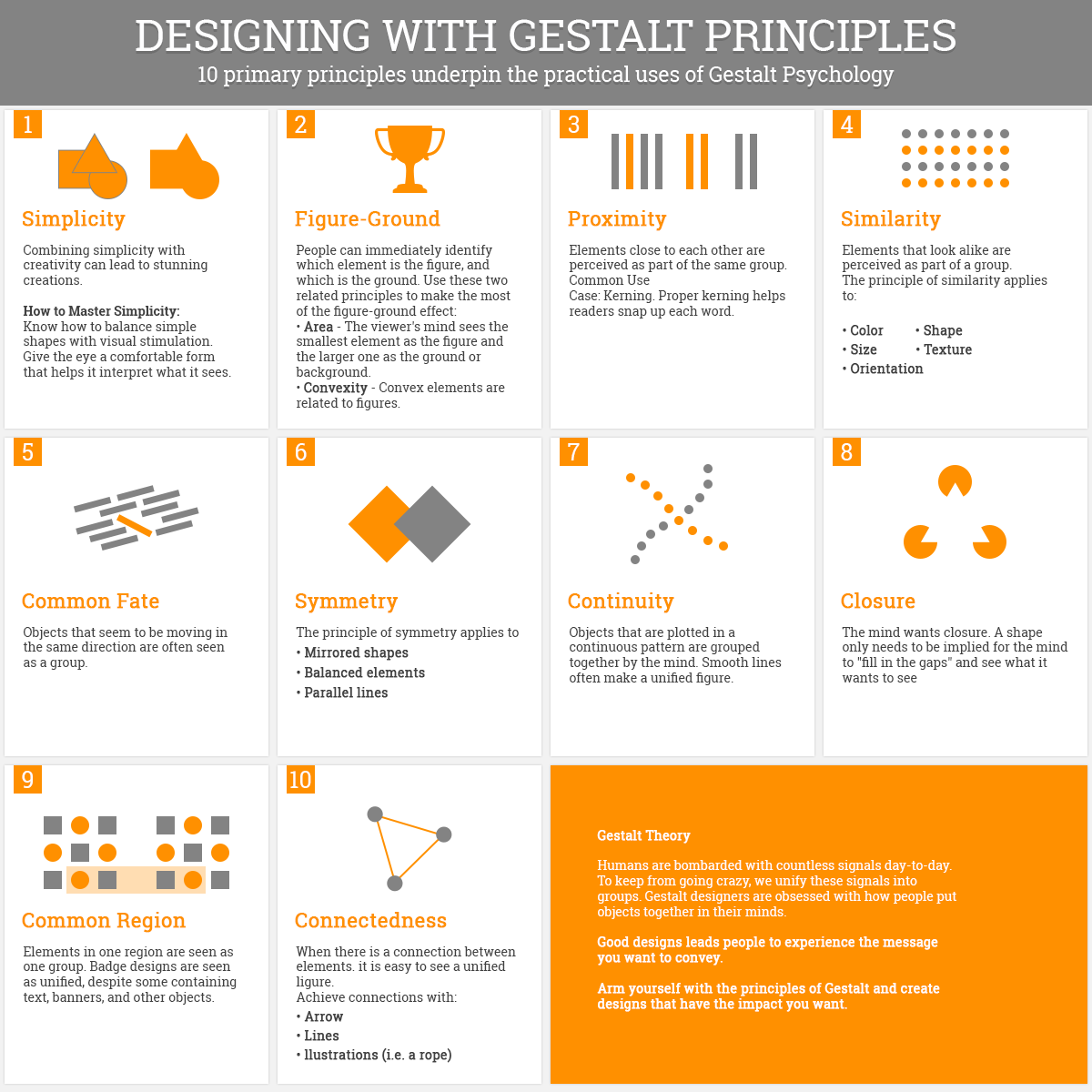
What is closure?
Perceiving incomplete shapes as complete
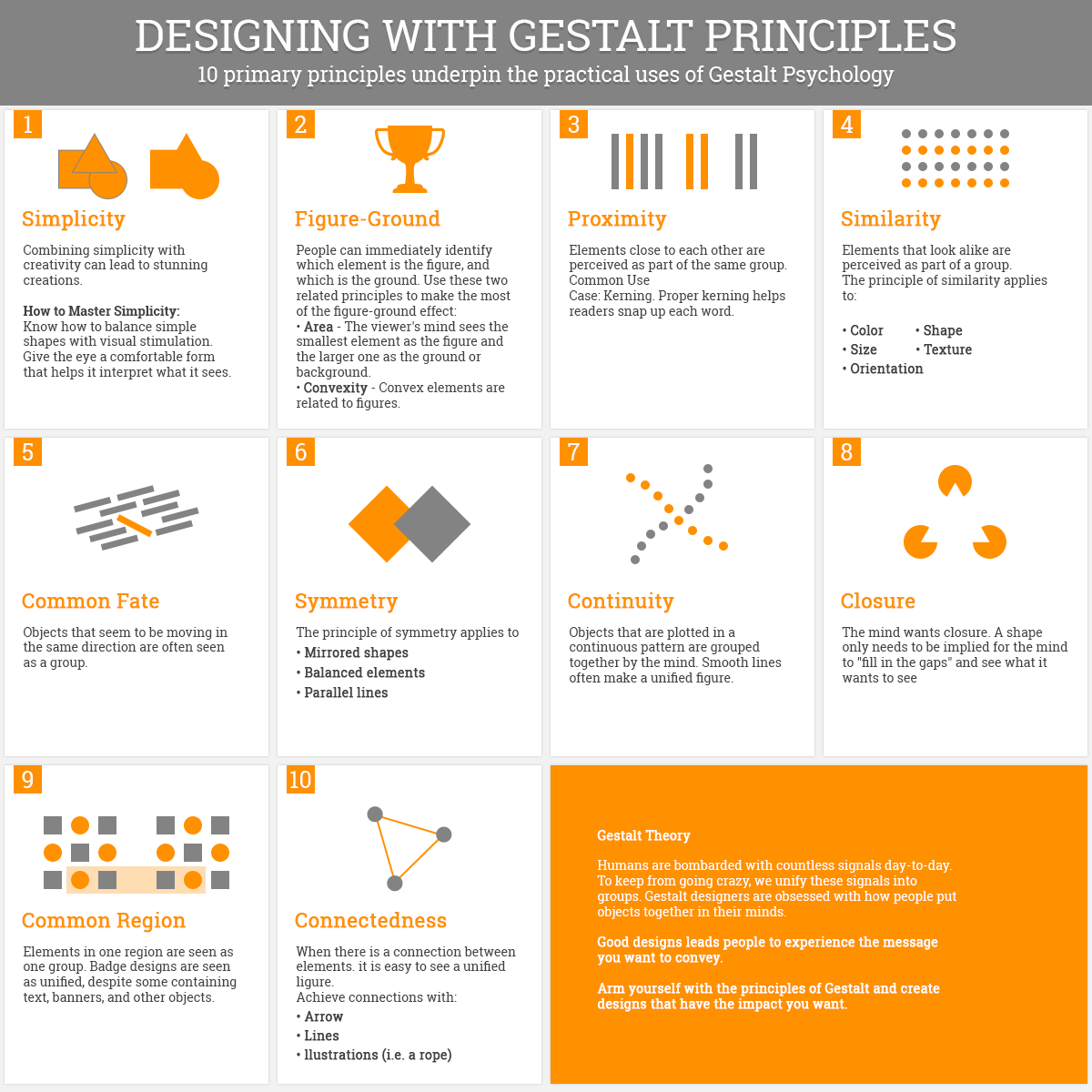
What is the feature detector approach (theory)?
How the brain processes visual stimuli by breaking it down into specific features
The shape and color of a sign to recognize warnings
What is perceptual constancy?
The ability to perceive objects as having the same size, etc even when their appearance changes due to various conditions
What is motion detection?
The brain’s ability to track the movement of objects
What is apparent motion?
Perception of movement where no real movement is occurring
What are examples of apparent motion?
Phi phenomenon and the stroboscopic effect
What is the phi phenomenon
Stationary lights flashing in rapid succession create an illusion of motion
What is the stroboscopic effect?
A sequence of still images creates an illusion of motion
What is the autokinetic effect?
When a stationary point of light in a dark room appears to move or twinkle
What is attention separated into?
Selective and divided attention
What is selective attention?
Focusing on one stimulus or task while ignoring distractions or irrelevant information
What are potential weaknesses of selective attention?
Inattentional blindness and change blindness
What is inattentional blindness?
Where a person is so focused on a specific task that they fail to notice important stimuli in their environment, like missing a person waving at them
What is change blindness?
When a person fail to notice changes in the environment
What is the cocktail party phenomenon?
A specific example of selective attention, showing that although we focus on a specific stimulus or task while ignoring other distractions, our brain still subconsciously processes the surrounding information like your name
What is divided attention?
The ability to focus on more than one task or stimulus simultaneously
What are the two types of perception?
Bottom-up processing and top-down processing
What is bottom-up processing?
A theory that the brain processes information by breaking down a stimulus into its component parts. These parts are then processed by sensory receptors, and the brain gradually builds recognition or understanding based on this raw data
What is top-down processing?
A theory that the brain processes information by using prior experiences and knowledge
What is Weber’s law?
A theory that the larger the initial stimulus, the difference required to notice a change is also larger
What is priming?
An effect where you recent experience with a stimulus influences how you process or respond to similar stimulus later. It can be done both consciously or unconsciously
What is priming separated into?
Repetition and semantic priming
What is repetition priming?
When you are repeatedly exposed to a specific stimulus, it becomes easier to recognize that same or similar stimulus later
A person can recall math problems and equations more quickly after practicing them
What is semantic priming?
Exposure to one word influences the response to another related word
Recognizing the word "banana" faster after seeing the word "yellow"
What is the tip-of-the-tongue phenomenon?
A phenomenon where you try to recall something but can’t quite get it out of your mind, even though you know it
What is learning separated into?
Associative and nonassociative learning
What is latent learning?
Learning that happens without any immediate reward, but becomes useful later when the situation calls for it, allowing us to create a cognitive map (mental maps of our environment)
What is insight learning?
A type of learning done where you solve a problem using a sudden understanding or realization
What is nonassociative learning?
A type of learning that occurs when an organism is repeatedly exposed to one type of stimulus
What is nonassociative learning separated into?
Habituation and sensitization
What is sensitization?
A temporary increase in responsiveness; hence, an exaggerated response due to a repeated or noxious stimulus
Water torture
What is desensitization?
Decreased emotional responsiveness to a noxious stimulus after repeated exposure
How can desensitization occur?
Naturally on its own or through systematic desensitization
What is systematic desensitization?
Treats anxieties by exposing people to the things they fear and avoid
What is associative learning separated into?
Classical conditioning, operant conditioning, and social learning
What is the Garcia effect?
A phenomenon where an organism learns to associate a particular taste or food with a negative experience, such as nausea or illness, leading to a strong aversion of that food
Why in the Garcia effect, aversion primarily works with food?
Because of our biological preparedness (our natural tendency to quickly learn things relevant to survival)
In the Garcia effect, aversion is highly resistant to extinction and can only be remembered by a single attempt. What is this called?
One-trial conditioning
What is classical conditioning separated into?
Forward and second-order conditioning
What is an unconditioned stimulus (US)?
The initially meaningful stimulus that caused a response
What is a conditioned response?
The learned response that occurs when exposed to the conditioned stimulus
What is forward conditioning?
A type of learning where the conditioned stimulus (CS) is presented before the unconditioned stimulus (US)
What is second-order conditioning?
A process of turning a previous neutral stimulus (NS) into the conditioned stimulus (CS; from forward conditioning) using an already established conditioned stimulus (CS) rather than an unconditioned stimulus (US)
What is the order of occurrence in classical conditioning?
Acquisition, generalization, discrimination, extinction, and spontaneous recovery
What is acquisition?
When the neutral stimulus (NS) is paired with the unconditioned stimulus (US) enough times that the neutral stimulus becomes a conditioned stimulus (CS), which then triggers a conditioned response (CR)
What is generalization?
The tendency to respond in the same way to different but similar stimuli
What is discrimination?
The ability to perceive and respond to differences among stimuli
What is extinction?
If the conditioned stimulus (CS) is repeatedly presented without the unconditioned stimulus (US), the conditioned response (CR) gradually decreases and eventually stops
What is spontaneous recovery?
After extinction, if a period of time passes and the CS is presented again, the conditioned response (CR) may briefly reappear, even though it was previously extinguished
What is counterconditioning therapy?
Using classical conditioning to help clients unlearn harmful emotional responses
What is operant conditioning?
A type of learning where behavior is controlled by reinforcements (rewards) or punishments to increase or decrease the likelihood of a behavior recurring
What is the law of effect by B.F. Skinner?
An idea that a behavior is more likely to recur if reinforced
What is shaping?
The process of training a learned behavior that would not normally occur
What is learned helplessness?
A psychological condition where an individual feels powerless to change their situation due to repeated failures
What is instinctive drift?
The limitation in shaping behaviors due to the fact that certain natural behaviors are essentially hardwired in the animal
What are primary reinforcements?
Things that satisfy innate biological needs
What are secondary reinforcements?
Things that are learned through their association with primary reinforcers
Money
What are positive reinforcements?
Adding a reinforcing stimulus in order to encourage the behavior
What are negative reinforcements?
The removal of an aversive event in order to encourage the behavior
What is omission training?
A technique used to decrease or eliminate a behavior by withholding a reward until the desired behavior is demonstrated
What are the schedule of reinforcements?
The frequency with which an organism receives reinforcement for a given type of response
What is a schedule of reinforcement separated into?
Continuous reinforcement schedule, partial (intermittent) reinforcement schedule
What is a continuous reinforcement schedule?
Every correct response that is emitted results in a reward
What is partial reinforcement schedule separated into?
Fixed-ratio schedule, variable-ratio schedule, fixed-interval schedule, and variable-interval schedule
What is a fixed-ratio schedule?
When the reward is given after a set number of behaviors
What is the variable-ratio schedule?
When the number of behaviors needed for reinforcement changes randomly
Ex. fishing, slot machines
What is the fixed-interval schedule?
When reinforcement is given after a set amount of time, as long as at least one behavior is done
Ex. salary payment, semester grades
What is a variable-interval schedule?
When a reinforcement is given at random times, as long as at least one behavior is done
Checking social media for notifications, pop quizzes, compliments from a teacher
What are positive punishments?
Pairing an unpleasant stimulus with the behavior
Ex. extra chore, receiving a fine
What are negative punishments?
The removal of a reinforcing stimulus after the the behavior has occurred
Ex. loss of screen time
Punishments typically have a lasting effect like reinforcements. Is this statement true or false?
False
What is social learning separated into?
Observational and vicarious learning
What is observational learning?
Learning by watching others perform a behavior
What is vicarious learning?
Learning by observing the outcomes like punishments and reinforcements
What is modeling?
Demonstrating a behavior for others to observe and imitate
What does the multi-store model explain?
How information is processed, stored, and retrieved, focusing on three key systems that information must pass through in order to be remembered
First, where does a stimulus enter?
Sensory memory, which includes echoic (auditory) and iconic (visual) memories
When a stimulus is in sensory memory, what kind of processing takes place?
Autonomic processing